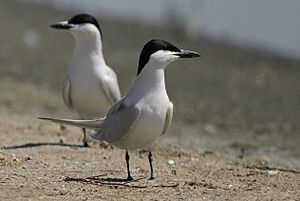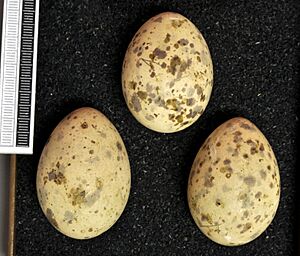Gull-billed tern facts for kids
Quick facts for kids Gull-billed tern |
|
|---|---|
 |
|
| Conservation status | |
| Scientific classification | |
| Genus: |
Gelochelidon
|
| Species: |
nilotica
|
 |
|
| Year-round Breeding Nonbreeding | |
| Synonyms | |
|
Sterna nilotica |
|
The gull-billed tern (Gelochelidon nilotica) is a type of tern bird. It belongs to the Laridae family, which includes gulls and terns. These birds live in many places around the world. They breed in parts of Europe, Asia, northwest Africa, and the Americas. The Australian gull-billed tern used to be thought of as the same species.
Contents
About the Gull-billed Tern's Name
The gull-billed tern was officially described in 1789. A German scientist named Johann Friedrich Gmelin gave it the scientific name Sterna nilotica. He wrote about it in his updated book, Systema Naturae.
Later, scientists studied the bird's DNA. Because of this, the gull-billed tern was moved to a new group, or genus, called Gelochelidon. This genus name comes from Ancient Greek words. Gelaō means "to laugh," and khelidōn means "swallow." The second part of its scientific name, nilotica, is Latin. It means "of the River Nile," because the bird was first described near the Nile River.
There are five different types, or subspecies, of gull-billed terns:
- G. n. nilotica: Found in Europe, North Africa, the Middle East, and parts of Asia.
- G. n. affinis: Lives in eastern Asia, including Japan, China, and Southeast Asia.
- G. n. aranea: Found in the eastern and southern United States and the Caribbean.
- G. n. vanrossemi: Lives from southern California to northwestern Mexico.
- G. n. gronvoldi: Found in South America, from French Guiana to northeastern Argentina.
What the Gull-billed Tern Looks Like
This tern is quite large and strong. It looks a bit like a Sandwich tern. But it has a short, thick beak that looks like a gull's. Its wings are wide, its legs are long, and its body is sturdy. These features help you tell it apart.
In summer, adult birds have grey backs and white undersides. They have a black cap on their head. Their bill and legs are black. The bird's call sounds like "ker-wik." Gull-billed terns are about 33 to 42 centimeters (13 to 17 inches) long. Their wings can spread 76 to 91 centimeters (30 to 36 inches) wide. They usually weigh between 150 and 292 grams (5 to 10 ounces).
In winter, the black cap on their head disappears. Instead, they have a dark patch around their eyes. Young gull-billed terns look a lot like winter adults. Their eye mask is just a bit lighter.
Where Gull-billed Terns Live and Travel
Gull-billed terns breed in warmer parts of the world. You can find them in southern Europe, parts of Asia, and both coasts of North and South America. There are several types of this bird. They mostly differ in size and small details of their feathers.
After breeding, these birds spread out. Those from northern areas travel the farthest. They spend winter in places like Africa, the Caribbean, South America, southern Asia, and New Zealand.
The gull-billed tern is a bird protected by an agreement. This agreement helps to conserve migratory waterbirds in Africa and Eurasia.
Life and Habits of the Gull-billed Tern
Reproduction
Gull-billed terns breed in groups called colonies. They make their nests near lakes, marshes, and coasts. This includes bays and earthen levees. They build a simple nest on the ground. Females usually lay two to five eggs. In Europe and Asia, they often breed near freshwater. But in North America, they mostly breed in salty, coastal areas.
Food and Feeding
The gull-billed tern is a bit different from other terns. It looks like a typical white tern. But it hunts for food more like marsh terns, such as the black tern. It usually does not dive headfirst into the water for fish. Instead, it has a wider variety of foods it eats.
This bird mostly catches insects while flying. It also often hunts over wet fields. Sometimes it even looks for food in bushy areas. It can catch amphibians and small mammals. Gull-billed terns are also good at finding food when they get a chance. They have been seen picking up dead dragonflies from roads.
Gallery
-
in Krishna Wildlife Sanctuary, Andhra Pradesh, India
-
Kazinga Channel, Uganda









